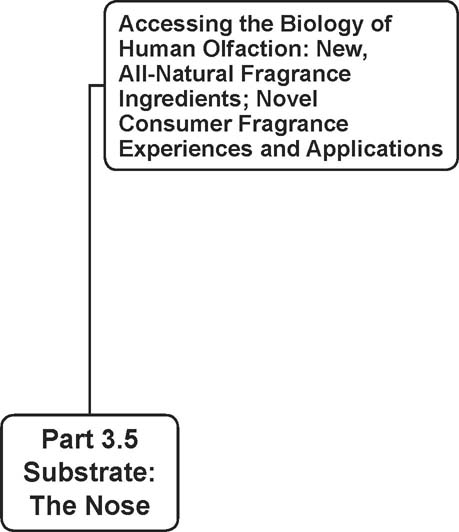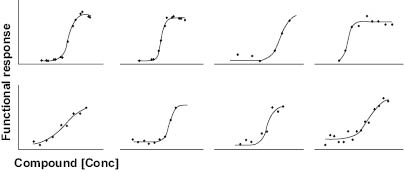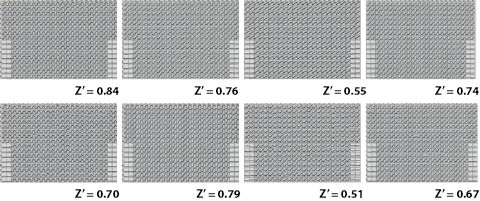THE NOSE

PART 3.5
THE NOSE:
Accessing the Biology of Human Olfaction:
New, All-Natural Fragrance Ingredients;
Novel Consumer Fragrance Experiences and Applications
by
Kambiz Shekdar, Visiting Scientist, Rockefeller University
ABSTRACT
Contemporary fragrance creation
Contemporary fragrance ingredient discovery and fragrance creation relies on sensory testing and evaluation methods by humans. Perfumers or experts discover new fragrance ingredients and they create new fragrance formulations while human sensory studies comprising panels of nonexpert or naïve human subjects are used for further evaluation. Whereas contemporary fragrance creation methods have been developed over decades and are considered the gold standard precisely because of their central reliance on humans, recent trends suggest that this process alone may soon become obsolete due to its lack of speed and throughput. First, consumer demand for products that are all-natural, economic, and sustainable is growing. In some consumer applications, synthetic ingredients have become a mainstay in the fragrance industry. At the same time, it is only becoming harder to identify natural fragrance ingredients that can be sourced reliably. Many natural ingredients are sourced from equatorial regions that are forecasted to suffer most severely from global warming and political instability. As a result, pressure for the rapid and reliable discovery of new, all-natural fragrance ingredients is increasing. In order to discover new fragrance ingredients for all-natural and sustainable products, new discovery methods that enable rapid and reliable testing of hundreds of millions of ingredients and extracts are required.
Next-generation fragrance creation
Borrowing from the fields of cell biology and drug discovery, the application of cell-based high-throughput screening (HTS) methods stand to enable the rapid and reliable testing of hundreds of millions of ingredients and extracts to aid in new fragrance ingredient discovery. Biologically, the sense of smell in humans is mediated by a family of ~350 odorant receptors. In principle, laboratory cells can be created to comprise odorant receptors. These cells could then be used as miniaturized detectors for “turbo smell testing” in cell-based assays to detect new fragrance ingredients. Ingredients identified as active in the cell-based assays could then be evaluated in human sensory studies or by perfumers. Importantly, the success or reliability of any cell-based assay depends on how closely it is produced to mimic the natural or native biology of the receptor it is designed to comprise. Recent advances in the science of cell-based assay creation reported across receptor classes—including drug, taste and odorant receptors—suggest that it is now possible, for the first time, to produce these assays such that they mimic the physiology of their intended receptors to a much greater degree than had been previously possible. In the context of olfaction in which such an especially large number of receptors are implicated, the advent of physiologically relevant cell-based assays in combination with expert and naïve human sensory methods will allow more rapid and reliable fragrance creation.
In this chapter we review:
- (i) the background on the biology of olfaction and the sense of smell
- (ii) the basic design and principles of miniaturized cell-based assays for high-throughput odorant ingredient discovery
- (iii) novel classes of previously inaccessible natural fragrance ingredients that stand to alleviate the emerging bottlenecks, including natural ingredients that augment, diminish, or otherwise modulate the sensory profile of fragrances, and the forward-looking and previously unknown applications that these enable, and
- (iv) recent understanding of the biology of odorant receptors as it relates to the creation of a fragrance-discovery engine with unprecedented high fidelity to the natural sense of smell.
In addition to facilitating the discovery of new natural ingredients and combinations of ingredients with desired aromatic properties, a systematic cell-based discovery engine could produce new fragrance ingredients for more precise further investigation of the biology and basis of human olfaction as well as create novel consumer products and applications. All in all, the advent of a rapid and reliable odorant ingredient discovery engine could open the gates to a whole new world of aroma research and product development.
The Biology of Olfaction and Fragrance Ingredient Discovery and Creation
3.5.2 Cell-Based High-Throughput Odorant Discovery—Principles and Basic Design
3.5.3 New Ingredients and Applications
The Biology of Olfaction and Fragrance Ingredient Discovery and Creation
Odorant receptors (ORs) are the biological entities that mediate the detection of scent. In humans, a family of at least ~ 350 genes encoding ORs has been identified. (1) This family or group of ORs are G-protein coupled receptors, or GPCRs. GPCRs are a classification of protein molecules localized in the outer membranes of cells. The ~350 ORs are integral membrane proteins; they traverse the cell membrane and comprise domains that are intracellular, transmembrane, or extracellular. While it is thought that certain odorant molecules may penetrate the cell membrane to impart their activity by interacting with transmembrane domains of the ORs, it is generally thought that it is the extracellular domains of ORs that mediate the detection of odorant molecules, as these domains would be most accessible to volatile compounds in the nasal cavity.
The ~350 GPCRs that have been described as odorant receptors are defined as such based both on their sequence homology and relatedness as well as their expression in cells that line the nasal epithelium. However, not each of these ORs has been confirmed as an odorant receptor. In addition, it is possible that other receptors in the nasal cavity and elsewhere may also play a role in human olfaction.
It may be helpful to think about the large family of ORs as the keys of a piano keyboard, where some odorant molecules will hit or activate one single receptor, or key, essentially sounding off one single aromatic note, whereas other more complex ingredients or substances may hit an entire chord, or several odorant receptors, all at once. Depending on which ORs are activated and how strongly, a different smell may be experienced or perceived in the brain.
3.5.2 CELL-BASED HIGH-THROUGHPUT ODORANT DISCOVERY’PRINCIPLES AND BASIC DESIGN
Cell-based high-throughput screening of ORs
High-throughput cell-based screening of ORs requires laboratory cells that are treated to comprise ORs. Typically, for any given OR, a gene encoding the OR must first be introduced into cells, and the OR that is encoded must be synthesized by the cell and transported to its outer (plasma) cell membrane, or cell surface. The preparation of cells used may be transiently transfected cells or they may be stable cell lines. Transiently transfected cells refer to populations of cells that are freshly introduced with the gene encoding the OR, where a new batch of cells is produced each time, as required for testing. Stable cell lines refer to clonal populations of cells where a single cell introduced with the OR gene is selected and used to create a clonally prepared population of genetically identical cells. The advantage of using transiently transfected cells includes speed, as the time required to produce a stable cell line is not necessitated, whereas the advantage of using stable cell lines includes identification of a population of cells with desired and well-characterized properties. There are many methods available to achieve either transiently transected cells or to produce stable cell lines, and these must be carefully considered given the host cell type used and the gene to be expressed in order to achieve the most physiologically relevant cells and assays. In this chapter, data for the use of stable cell lines are presented.
In addition, creation of laboratory cells that comprise ORs that function as they do in their natural setting in vivo is challenging. The cells of the nasal epithelium that typically express ORs in vivo are highly specialized, polarized cells that are not approximated by typical laboratory cell cultures, which comprise cells derived from various tumors or are otherwise immortalized. Current methods for the production of cells suitable for HTS of ORs are described in the last section of this chapter. Once cells comprising the OR are produced, a cell-based assay that can be used to monitor the activity of the OR must also be produced. The activation of many classes of GPCRs, including ORs, results in an influx of calcium into the cytoplasm or interior of the cell. Therefore, the use of fluorogenic dyes that can be used to report the presence and concentration of calcium is common. Figure 1 shows cell-based assay responses for a panel of eight cell lines, each comprising a different native and full-length OR (See Figure 1).

Figure 1 A cell based assay was used to test the activity of a set of 8 different ORs in response to an activating compounds. Dose response curves are shown. For each OR, a compound with an EC50 value of less than 100 µM is shown. The assay response (Y-axis) over time (X-axis) is shown.
High-throughput screening and discovery of new fragrance ingredients
Once a cell-based assay is created, it must be miniaturized to high-throughput format, where typically 384-well plate or 1536-well plate microtiter well plates are used to interrogate the activity of many different samples on the OR at any given time. As the testing of a plate requires on the order of one to five minutes only, hundreds of millions of extracts and ingredients may be tested on a 24-hour basis using standard automated and scalable screening instrumentation.
In HTS assays, it is important that the assay response is sufficient and consistent for reliable discovery of modulators. That is, in each well tested with an activator of the receptor, the signal-to-noise ratio of the response generated in the cell-based assay compared to buffer-only control must be great enough to enable reliable detection of either a modulator or blocker. In addition, this assay response must be consistent from well to well, to enable comparison of testing results for different compounds and ingredients across a plate. One common measure of the suitability of a miniaturized cell-based assay for HTS is the value for the Z´ Factor of the assay. The Z´ Factor of an assay is derived using an equation that takes both the signal-to-noise ratio and the well-to-well consistency of the assay response into account, with values ranging from 0 to 1. (2)
Typically, a cell-based assay with a Z´ Factor value of 0.4 or greater is considered suitable for HTS. Figure 2 shows OR cell-based assays with Z´ Factor values suitable for the HTS for the same set of eight receptors as depicted in Figure 1.

Figure 2 The same set of ORs as shown in Figure 1 were miniaturized to 384-well plate HTS assay format. Responses for the testing of the 384-well plate assays with an activating compound (dark shaded) or buffer-only control (light shaded) are shown. Z’ values of at least 0.4 were generated for each OR.
Once cell-based assays with a suitable Z´ Factor are established, the first step in discovering new odorant ingredients for a given application is to determine which of the panel of ~350 known ORs are relevant for the desired application. To do this, a panel of cells representing the entire family of ORs is exposed to the aromatic substance and the ORs that are activated in response to it are identified. To identify the ORs that correspond to the aroma of a rose extract, for instance, the receptors that respond upon exposure to the extract are selected. Aromatic substances like rose extract often comprise hundreds or thousands of aromatic ingredients. It is the combination of the aromatic or sensory profile of each ingredient that produces the net or perceived sensory experience or fragrance. Often, the key aromatic notes of a composite fragrance are derived from one or a few of these ingredients. Careful testing and analysis must be used to select the most meaningful set of ORs for HTS for any given aromatic substance of interest. Figure 3 shows the response of 320 compounds and extracts tested across the same set of ORs as shown in Figure 1
Stay updated, free articles. Join our Telegram channel

Full access? Get Clinical Tree








